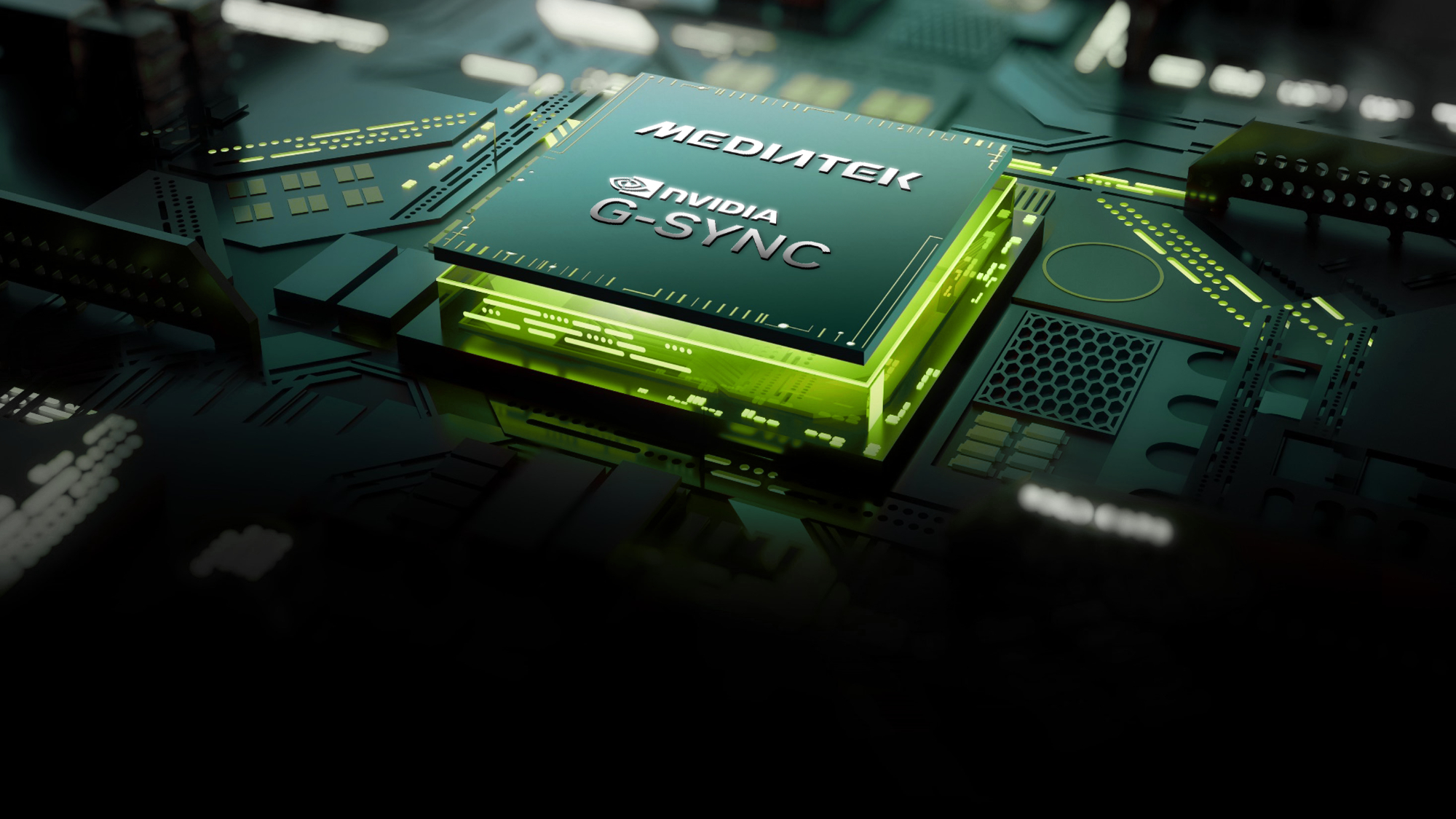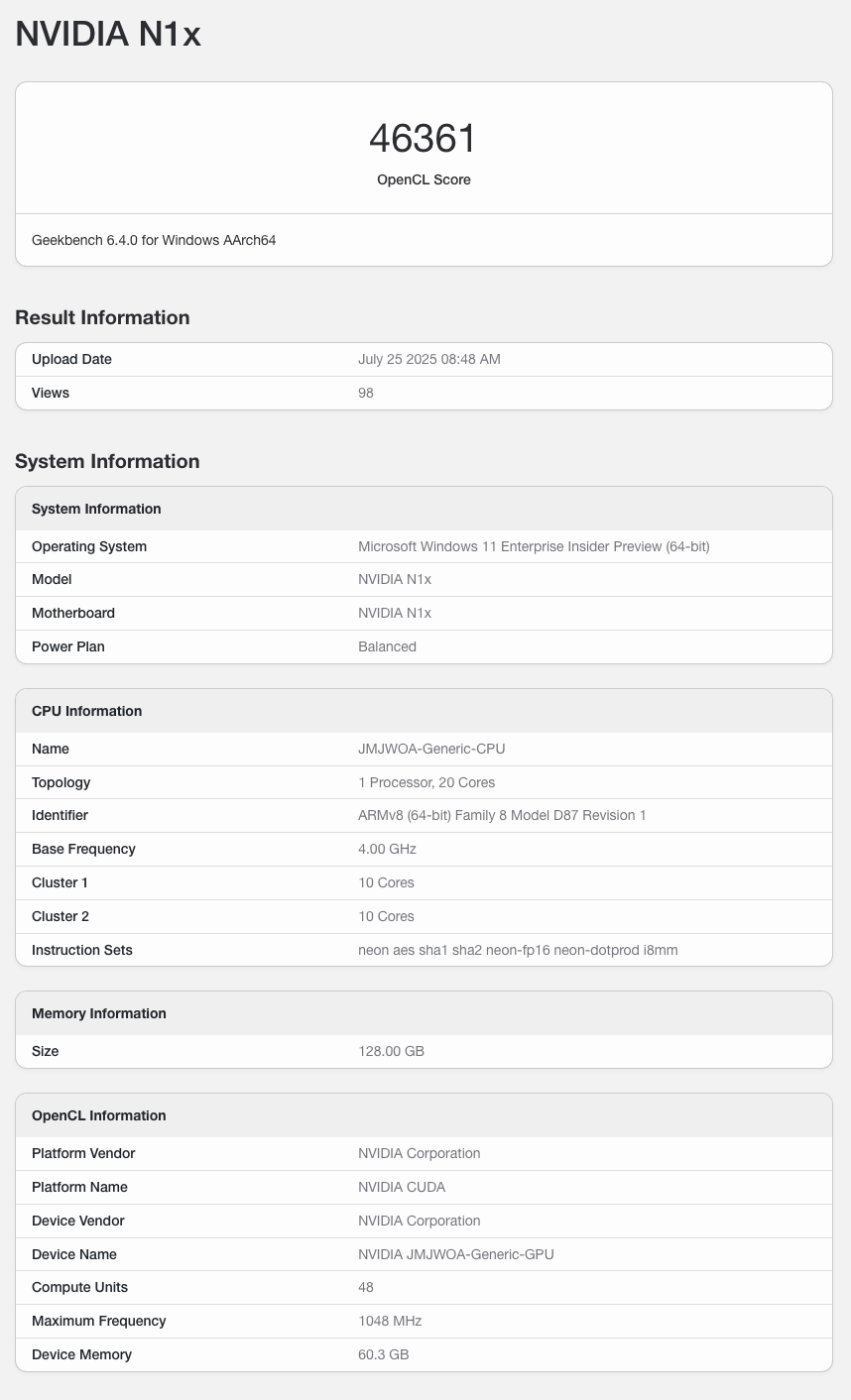Nvidia N1X SoC leaks with the same number of CUDA cores as an RTX 5070 — N1X specs align with the GB10 Superchip

Nvidia's long-rumored and long-delayed N1X SoC has broken cover once again, this time revealing its GPU capabilities through a fresh Geekbench OpenCL listing. We've seen various CPU-focused leaks surrounding this chip before, but this provides our first genuine look at the GPU. That being said, this isn’t final silicon—it’s an early engineering sample—but the details are enough to show where Nvidia is headed with its first consumer-class ARM SoC for laptops and possibly desktops.
The Geekbench entry confirms a 20-core CPU setup split into two 10-core clusters, built on Nvidia’s Grace architecture. More importantly, it confirms 48 Streaming Multiprocessors (SMs), translating to 6,144 CUDA cores—the exact count as the desktop GeForce RTX 5070. Interestingly, these specs also match Nvidia’s GB10 Superchip, which currently powers the DGX Spark AI mini-PCs, suggesting that N1X might be a repurposed, possibly lower-power version aimed at the mainstream market. After all, they're both ARM-based chips developed in unison with MediaTek.
Performance, however, is still in the rough. This sample clocked in at a modest 1.05 GHz and scored 46,361 in OpenCL, roughly in the territory of the RTX 2050. The reason is power and frequency limits, which are typical of early prototypes, as well as the absence of dedicated GDDR memory, since the SoC relies on shared LPDDR5X.

Even in this state, the N1X’s iGPU is already outpacing every modern integrated GPU, including Apple’s M3 Max and AMD’s 890M, which top out at around 37,500 in similar benchmarks. The GPU performance ceiling is higher, given that a fully powered RTX 5070 boosts to 2.5 GHz with a 250W TDP, while the N1X is capped at around 120W for the entire chip.
This isn’t the first time the N1X has appeared on Geekbench. Earlier leaks revealed its CPU performance was competitive but not earth-shattering, which is to be expected from unfinished drivers and firmware. With the latest listing, Nvidia is signaling a hybrid approach: pairing a Blackwell GPU core array with an ARM-based CPU cluster, aiming for a balance of AI performance, gaming, and efficiency—similar to how AMD’s Strix Halo and Apple’s M-series chips are positioned.
There’s still no launch date in sight. Rumors suggest a Q1 2026 release, possibly timed to coincide with the next wave of AI-focused Windows laptops, as Microsoft appears to be holding up on that at the moment. For now, Nvidia's N1X sits in the shadows, a prototype with the specs of a mid-tier discrete GPU and ambitions to push iGPU performance into uncharted territory.
If Nvidia gives this chip the power and bandwidth it needs, the N1X could be the first ARM-based SoC to seriously challenge x86 giants like AMD and Intel on high-performance laptops—and maybe even take a bite out of Apple’s lead in the premium AI laptop segment.
Get Tom's Hardware's best news and in-depth reviews, straight to your inbox.
Follow Tom's Hardware on Google News to get our up-to-date news, analysis, and reviews in your feeds. Make sure to click the Follow button.

Hassam Nasir is a die-hard hardware enthusiast with years of experience as a tech editor and writer, focusing on detailed CPU comparisons and general hardware news. When he’s not working, you’ll find him bending tubes for his ever-evolving custom water-loop gaming rig or benchmarking the latest CPUs and GPUs just for fun.
-
jlake3 Software support and pricing is going to make or break this thing. The iGPU on Apple's "Max" chips has theoretically been amazing for a mobile platform ever since the M1 Max, but the catalog of Apple Silicon optimized AAA titles has been too narrow and the price of hardware too high for the M4 Max MacBook Pro to get any gaming recommendations.Reply
If laptops with these chips come in at $2,000+, but you can only play Nvidia-sponsored new releases natively and older games end up stuck with a translation layer that isn't absolutely top-notch... that's not gonna be great. And if these are only a small sliver of the Windows gaming market, getting people to optimize and QA for Windows-on-ARM without an Nvidia sponsorship may be hard. -
usertests Reply
In the Geekbench OpenCL benchmark, Strix Halo 8060S is "between" the 5070 and the early N1X result. Strix Halo is 94% faster than the N1X, and RTX 5070 is 106% faster than Strix Halo. The N1X is going to get better than that, but how much?Amdlova said:AMD and Intel is ded
https://www.tomshardware.com/tech-industry/semiconductors/nvidias-desktop-pc-chip-holdup-purportedly-tied-to-windows-delays-ongoing-chip-revisions-and-weakening-demand-also-blamed
We have a bunch of blame going around for why the N1X is not coming soon. Eventually, it will be competing with faster Medusa Halo (2027?). -
Mr Majestyk So Moore's Law is Dead was right. 6 months ago he said Nvidia insiders told him they were going for AMD's jugular and wanted to dominate Strix Halo. If these specs are in final silicon, this would really put a cat amongst the pigeons, even more so with strong rumours Medusa Halo is cancelled. Qualcomm should be even more worried as their iGPU even in second gen Oryon will be light years behind. As much as I loathe Nvidia, this sounds exciting. This would also be a monster for productivity. I hope by the time of release, Windows for ARM is more polished and the vast majority of apps I would use run on ARM natively, rather than rely on emulation.Reply -
Pierce2623 Reply
I really don’t see this chip hugely affecting AMD at all. It will require emulation/translation layers to run anything that’s x86. ARM won’t have a chance of taking the client PC market until they make an effort get the big publishers to get most modern AAA games running natively on ARM. Emulating PC games on newer high powered ARM devices is gaining a lot of popularity, but it’s silly to burn Steam Deck levels of power to get half the Steam Deck’s performance on better than Steam Deck hardware because you’re playing through an x86 to ARM emulation layer with DXVK bootstrapped to the top because nobody gives phone GPUs DirectX compatibility, even the damn literal RDNA GPU Samsung buys in from AMD doesn’t have DieectX support.Amdlova said:AMD and Intel is ded -
aberkae Reply
For me if Nvidia decided to develop thier own OS or use Steam OS as primary or secondary OS would actually be more exciting than having to rely on Windows for growth for maximum low level efficiency. Will put Microsoft on notice and might start to threaten Apple as well.jlake3 said:Software support and pricing is going to make or break this thing. The iGPU on Apple's "Max" chips has theoretically been amazing for a mobile platform ever since the M1 Max, but the catalog of Apple Silicon optimized AAA titles has been too narrow and the price of hardware too high for the M4 Max MacBook Pro to get any gaming recommendations.
If laptops with these chips come in at $2,000+, but you can only play Nvidia-sponsored new releases natively and older games end up stuck with a translation layer that isn't absolutely top-notch... that's not gonna be great. And if these are only a small sliver of the Windows gaming market, getting people to optimize and QA for Windows-on-ARM without an Nvidia sponsorship may be hard.
Crazy how Intel is ironically about to really be in the rear view mirror if it doesn't get it's footing right. Also this might cause AMD to upgrade it's APUs to a higher rdna/udna nomenclature than the 3.5 version in current lineup which is also inferior to the ai capabilities of Intel's mobile apus xess and frame gen found in the ultra 258v. By the time this comes out Intel will surely have a successor to Lunar lake 288v or whatever the direct competitor chip is.
While the gpu side obviously Nvidia has the lead on all but when it comes to the cpu its a tough competition. Nvidia needs to get this right and start swinging out the gate. Hopefully the delay gives all players time to fortify their positions accordingly for some healthy competition in this space. -
Amdlova The big "AAA" almost stuck with the gamergate 2.0Reply
Intel is almost dead...
Only AMD making chips every one will jump to ARM cpus. Server/enterprise level has 10% market share, Amd has 27% ish.
https://www.tomshardware.com/pc-components/cpus/arm-aims-to-capture-50-percent-of-data-center-cpu-market-in-2025
Nvidia will make everything to take a big piece of this pie. -
purposelycryptic Sounds great... For a new Nvidia Shield TV release. I'd definitely buy that, even if the price was quite ugly.Reply
As a PC, though?
It's still Windows-on-ARM, a platform desperately trying to justify its existence in a scenario where the only benefit it offers users is a minor advantage in power efficiency over x86, at the cost of significant and unpredictable compatibility issues with its x86 emulation, and zero incentive for developers to go out of their way to waste their time and money making a native port.
No one asked for this - it continues to be the product of corporations joining hands to create something new to make money off of, rather than coming up with a a solution for an existing hole in the market. It's a solution in search of a problem, and always will be.
The technology itself is cool, it's just such a shame it is getting wasted on something so pointless. -
Notton I don't think N1X will dethrone Strix Halo.Reply
From a performance viewpoint, both N1X and Strix Halo have memory bandwidth constraints when compared to a 5070 or 9070XT.
5070 has 672GB/s, while GB10 (N1X) has 273GB/s. That's less than half.
From a software perspective, Strix Halo works better on Linux than Windows, but they both work.
Where as N1X is struggling with Windows on ARM, but it might support Linux out of the box, since DGX spark is supposed to ship with Linux. And then there is the Mediatek equation. Their drivers leave a lot to be desired in both Windows and ARM. They are particularly bad when it comes with Wifi and BT signal quality.
From a pricing perspective, DGX Spark costs $4000 while GX10 Ascent is $3000
Strix Halo 395 desktop from Framework is $2000 baseline.
At >$3000, and especially >$4000, you might want to look into a System76 Ampere based system.